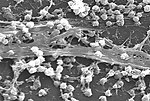Escherichia coli (/ˌɛʃəˈrɪkiə ˈkoʊlaɪ/ ESH-ə-RIK-ee-ə KOH-lye) is a gram-negative, facultative anaerobic, rod-shaped, coliform bacterium of the genus Escherichia...
107 KB (11,156 words) - 00:00, 24 December 2024
Enterotoxigenic Escherichia coli (ETEC) is a type of Escherichia coli and one of the leading bacterial causes of diarrhea in the developing world, as...
7 KB (729 words) - 14:05, 7 July 2024
Escherichia coli O157:H7 is a serotype of the bacterial species Escherichia coli and is one of the Shiga-like toxin–producing types of E. coli. It is a...
22 KB (2,347 words) - 19:20, 8 January 2025
of Escherichia coli. Escherichia are facultative aerobes, with both aerobic and anaerobic growth, and an optimum temperature of 37 °C. Escherichia are...
8 KB (636 words) - 17:25, 15 October 2023
Escherichia coli (/ˌɛʃəˈrɪkiə ˈkoʊlaɪ/ ESH-ə-RIK-ee-ə KOH-ly; commonly abbreviated E. coli) is a gram-negative, rod-shaped bacterium that is commonly found...
55 KB (5,910 words) - 14:50, 29 January 2025
Enteroinvasive Escherichia coli (EIEC) is a type of pathogenic bacteria whose infection causes a syndrome that is identical to shigellosis, with profuse...
6 KB (629 words) - 11:53, 12 December 2024
Shigatoxigenic Escherichia coli (STEC) and verotoxigenic E. coli (VTEC) are strains of the bacterium Escherichia coli that produce Shiga toxin (or verotoxin)...
21 KB (2,266 words) - 05:51, 9 December 2024
Enteroaggregative Escherichia coli (EAEC or EAggEC) are a pathotype of Escherichia coli which cause acute and chronic diarrhea in both the developed and...
19 KB (2,126 words) - 14:03, 7 July 2024
Nucleoid (redirect from Architecture of the Escherichia coli nucleoid)
nucleoid, however key features have been researched in Escherichia coli as a model organism. In E. coli, the chromosomal DNA is on average negatively supercoiled...
151 KB (17,185 words) - 06:38, 8 August 2024
McDonald's stores in 14 U.S. states. At least 104 people contracted Escherichia coli, and one person died. The Food and Drug Administration (FDA) issued...
9 KB (875 words) - 22:32, 7 January 2025
Escherichia coli Nissle 1917 is a strain of Escherichia coli that was isolated from the feces of a German soldier in 1917 by the German researcher Alfred...
2 KB (178 words) - 14:55, 29 January 2025
tracking genetic changes in 12 initially identical populations of asexual Escherichia coli bacteria since 24 February 1988. Lenski performed the 10,000th transfer...
54 KB (6,637 words) - 15:12, 24 December 2024
Coliform bacteria (section Escherichia coli O157)
polysaccharides on their cell surface or by using selective medias. Escherichia coli (E. coli) can be distinguished from most other coliforms by its ability...
16 KB (1,881 words) - 21:51, 2 September 2024
Escherichia coli BL21(DE3) is a commonly used protein production strain of the E. coli bacterium. This strain combines several features that allow for...
6 KB (582 words) - 16:47, 19 January 2025
Mesophile (section Escherichia coli)
mesophiles include Listeria monocytogenes, Staphylococcus aureus, and Escherichia coli. Other examples of species of mesophiles are Clostridium kluyveri,...
12 KB (1,442 words) - 03:12, 3 August 2024
Escherichia coli O104:H4 is an enteroaggregative Escherichia coli strain of the bacterium Escherichia coli, and the cause of the 2011 Escherichia coli...
9 KB (1,029 words) - 16:20, 7 November 2023
milk cheeses as vehicles for infection by Verocytotoxin-producing Escherichia coli". International Journal of Dairy Technology. 62 (3): 293–307. doi:10...
26 KB (2,940 words) - 02:02, 14 November 2024
Two-hybrid screening (redirect from Escherichia coli two hybrid screen)
interactions, as well as methods that use different host organisms such as Escherichia coli or mammalian cells instead of yeast. The key to the two-hybrid screen...
47 KB (6,112 words) - 20:59, 24 January 2025
Escherichia coli (/ˌɛʃɪˈrɪkiə ˈkoʊlaɪ/; commonly abbreviated E. coli) is a Gram-negative gammaproteobacterium commonly found in the lower intestine of...
23 KB (2,618 words) - 05:05, 18 November 2024
American E. coli outbreak E. coli O104:H4, also 2011 E. coli O104:H4 outbreak Escherichia coli O121 Escherichia coli O104:H21 Escherichia coli K1, meningitis...
3 KB (172 words) - 21:37, 18 November 2024
Beta-lactamase (section Escherichia coli or Klebsiella)
ESBL-producing E. coli Nitrocefin Antimicrobial resistance Neu HC (June 1969). "Effect of beta-lactamase location in Escherichia coli on penicillin synergy"...
53 KB (6,271 words) - 11:11, 29 December 2024
Biofilm (section Escherichia coli)
nucleic acids. Escherichia coli biofilms are responsible for many intestinal infectious diseases. The Extraintestinal group of E. coli (ExPEC) is the...
121 KB (14,157 words) - 11:34, 20 December 2024
gastrointestinal tract. E. coli (not to be confused with the bacterium Escherichia coli) is important in medicine because it can be confused during microscopic...
13 KB (1,517 words) - 22:36, 22 January 2025
produced by Escherichia coli. The most common sources for Shiga toxin are the bacteria S. dysenteriae and some serotypes of Escherichia coli (shigatoxigenic...
20 KB (2,313 words) - 14:46, 2 November 2024
Ore., Wash., after 22 sick from E. coli". USA Today. "Multistate Outbreak of Shiga toxin-producing Escherichia coli O26 Infections Linked to Chipotle Mexican...
175 KB (16,463 words) - 19:06, 18 January 2025
The 2024 United Kingdom shigatoxigenic E. coli outbreak was a Shigatoxigenic Escherichia coli (STEC) O145 outbreak that is believed to have occurred in...
6 KB (596 words) - 20:17, 21 December 2024
Escherichia virus T4 is a species of bacteriophages that infect Escherichia coli bacteria. It is a double-stranded DNA virus in the subfamily Tevenvirinae...
43 KB (5,371 words) - 18:28, 12 June 2024
infrequently associated with cruise ships. Enterotoxigenic Escherichia coli is a form of E. coli and the leading bacterial cause of diarrhea in the developing...
100 KB (10,528 words) - 13:51, 15 January 2025
each sample's extent of staining. In gram-negative bacteria, such as Escherichia coli, alkaline phosphatase is located in the periplasmic space, external...
55 KB (6,147 words) - 10:20, 8 January 2025
examples of facultatively anaerobic bacteria are Staphylococcus spp., Escherichia coli, Salmonella, Listeria spp., Shewanella oneidensis and Yersinia pestis...
11 KB (997 words) - 22:06, 3 October 2024
















